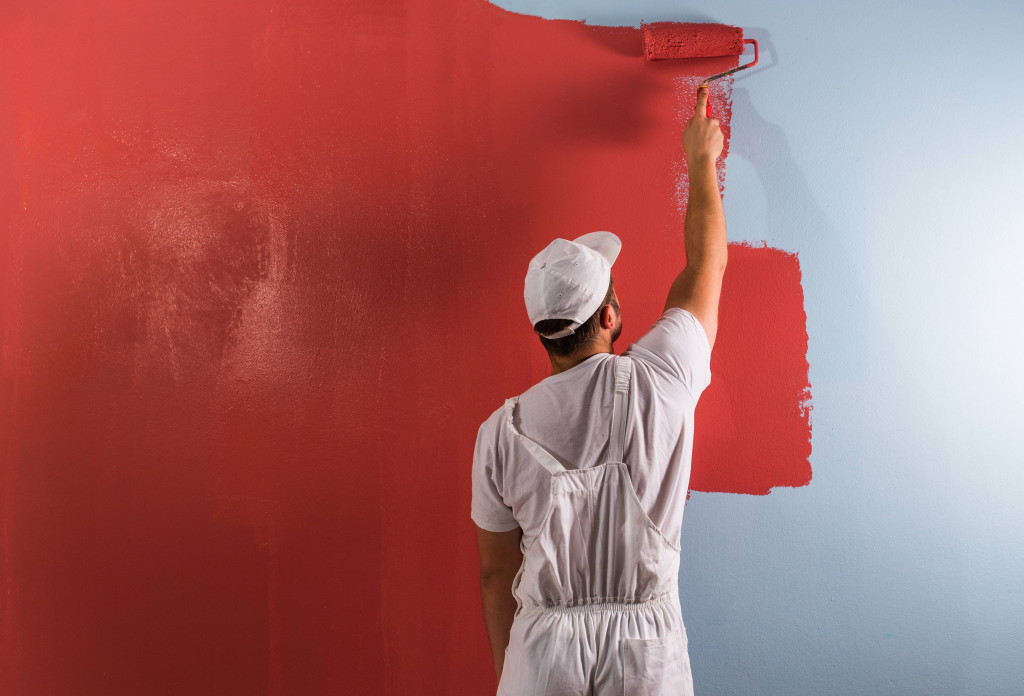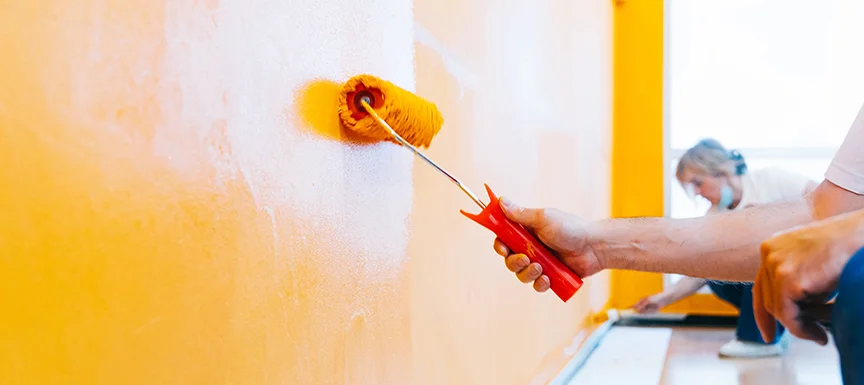Choose the Perfect Paint Finish for Any Room at a paint store corpus christi tx
Keep Ahead With New Paint Trends: Blending Techniques for Modern Interiors

The Rise of Color Gradients in Interior Style
As designers significantly seek innovative ways to enhance areas, the surge of shade gradients in indoor design has amassed significant attention. This technique, defined by the smooth change between two or more shades, permits a vibrant visual result that can transform an ordinary area into a vivid environment. Shade slopes can evoke emotions, affect assumptions of area, and produce focal points, making them a versatile option for different style styles.
The application of slopes extends beyond wall surfaces; they can be effectively utilized in furniture, textiles, and accessories. Developers frequently trying out varying tones to achieve deepness and intrigue, appealing to a variety of visual appeals from minimal to diverse. Additionally, the flexibility of gradients allows their use in both household and commercial settings, dealing with diverse customers. As fads develop, using color slopes signifies a change in the direction of more expressive and personalized indoor rooms, mirroring individual tastes and way of livings.
Embracing Ombre Strategies for a Dynamic Look
Ombre techniques have become a charming choice for those wanting to add depth and activity to contemporary insides. This slope effect shifts smoothly from one shade to one more, developing an aesthetically striking focal factor in any kind of room. Designers appreciate ombre for its flexibility; it can be used to wall surfaces, furniture, and even attractive accents, permitting one-of-a-kind expressions of design.
The technique functions especially well with soft hues, giving a tranquil atmosphere, while strong shades can invigorate an area. House owners can explore various shade combinations, selecting contrasting tones for a dramatic effect or unified tones for a subtle result. The application of ombre is not limited to a solitary wall; it can prolong across a space, boosting the understanding of space and light.
As a modern fad, ombre methods cater to diverse preferences, enabling people to customize their interiors and embrace creativity in their style technique. paint store corpus christi tx.
Textured Wall Surfaces: Layering Paint for Depth and Passion
Textured walls can greatly improve the visual charm of modern interiors by including deepness and interest. Techniques for producing appearance, thoughtful color combinations, and the right tools for layering are important elements in attaining this effect. Exploring these aspects enables a vibrant and customized strategy to interior decoration.
Methods for Appearance Creation
Developing aesthetic interest in indoor spaces usually rests on the artistic application of appearance. Numerous strategies can be used to attain this, such as sponging, cloth rolling, and stippling. Sponging entails making use of a wet sponge to use a 2nd shade over a skim coat, developing a soft, mottled effect. Rag rolling, on the other hand, utilizes a rolled dustcloth to apply paint, causing a much more dynamic structure. Stippling uses a stiff brush or tool to swab paint onto the surface area, creating a special pattern. Additionally, layering various coatings, such as matte and glossy, can enhance depth. These methods not only offer visual appeal but also add to the general ambiance of modern insides, encouraging a responsive experience.
Color Combinations for Influence
Layering paint not only boosts appearance yet also opens a world of shade mixes that can significantly affect the state of mind of a room. By mixing complementary tones, developers can develop an unified impact that invites warmth or coolness, depending on the wanted environment. For instance, abundant earth tones paired with soft pastels can stimulate a calm atmosphere, while bold, different shades can include vibrancy and energy. In addition, incorporating metallic or glossy coatings within the layers can present a dynamic visual component, capturing light and boosting the depth of the color design. Eventually, thoughtful color combinations through layering paint supply a possibility to reveal specific style while transforming ordinary walls into enchanting centerpieces.
Tools for Layering Result
Numerous devices are essential for achieving a successful layering effect in paint applications, which can transform walls into bewitching visual experiences. Rollers and brushes are essential, with different sizes enabling different appearances and surfaces. Specialized tools like sponges and rags can produce one-of-a-kind patterns and deepness, while palette blades use accuracy for more defined lines. For larger locations, making use of a stippling brush can include an elaborate finish. Furthermore, spray weapons can efficiently apply numerous layers for a smooth, also layer. Painters need to additionally consider painter's tape to create clean edges between layers. By utilizing the right tools, one can successfully improve the aesthetic charm of interiors, making each wall an intriguing centerpiece.

The Power of Color Blocking in Modern Spaces
As modern-day indoor layout proceeds to progress, color blocking emerges as an effective method that can change areas with strong visual influence. This method involves the tactical positioning of contrasting colors to produce defined areas within a space, enhancing both the aesthetic allure and functionality read more of the room. corpus christi tx paint shop. By using huge swathes of color, designers can guide the eye and stress architectural elements, leading to a vibrant ambience
Color blocking is not limited to walls; it can also be applied to furniture and decoration, permitting for unlimited modification. For instance, matching a lively hue with a neutral tone can produce a striking prime focus while preserving balance. This strategy motivates creativity, enabling property owners to share their individualities via one-of-a-kind color mixes. Inevitably, shade blocking offers as a reliable means to rejuvenate modern-day insides, making spaces feel fresh, energised, and aesthetically appealing.
Incorporating Metallics for an Attractive Complete
Exactly how can metallics raise the sophistication of modern interiors? Metallic surfaces act as a striking prime focus, including depth and aesthetic rate of interest to spaces. They can transform a common area right into an elegant resort via the subtle interplay of light and reflection. Developers often advise incorporating metallics in accent walls, ceilings, or furnishings to develop an elegant ambience without overwhelming the room.
Different metal shades-- such as bronze, silver, and gold-- use flexibility, permitting home owners to personalize their aesthetic. For circumstances, a soft gold can pass on heat, while a sleek silver can offer a contemporary touch. When coupled with neutral tones, metallics boost the general layout, offering a sophisticated comparison that attracts the eye.
Integrating metallic paint into trim or moldings can additionally boost architectural information, creating a polished finish. Eventually, the critical use metallics can infuse contemporary insides with glamour and refinement, making them really enchanting.
Innovative Use Stencils for Unique Patterns
Changing walls with stencils can instill contemporary insides with distinctive personality and design. This artistic technique enables designers and property owners to create tailored patterns that mirror individual visual appeals. Stencils can vary from elaborate geometric designs to whimsical themes, allowing a large range of expressions. By choosing different colors, patterns can raise a space's visual appeal and act as centerpieces without overwhelming the space.
Additionally, stencils are functional; they can be related to different surface areas, consisting of walls, furniture, and also ceilings. This versatility makes stenciling a suitable choice for DIY fanatics looking to improve their space affordably. Furthermore, the ease of application and elimination enables trial and error, allowing individuals to freshen their decoration with marginal initiative. Ultimately, innovative usage of patterns not just changes normal surfaces yet also offers a chance for self-expression, making them a trending selection in modern interior design.
Mixing Matte and Glossy Coatings for Contrast
The interaction of matte and glossy finishes can develop a striking visual dynamic in modern insides. Designers typically utilize this contrast to boost architectural features and specify spaces. Matte surfaces, with their soft, non-reflective high quality, can develop a sense of warmth and intimacy, making them perfect for walls and larger surfaces. On the other hand, glossy surfaces reflect light, including vibrancy and depth, making them suitable for accents such as trim, moldings, or furniture.
The mix of these appearances can assist the eye and stress prime focus within a room. Matching a matte-painted wall surface with shiny kitchen cabinetry can develop a sophisticated equilibrium. Additionally, the careful application of both surfaces can evoke numerous moods while boosting the total visual. As homeowners increasingly look for tailored areas, mixing matte and shiny finishes provides a flexible strategy to achieving contemporary beauty and aesthetic rate of interest in interior decoration.
Often Asked Inquiries
What Tools Are Best for Blending Paint Methods?
A selection of devices are optimal for mixing paint methods, consisting of foam rollers, brushes with soft bristles, sponge applicators, and airbrushes. Each tool offers special results, enhancing the blending process for different artistic applications.
How Can I Repair Blending Mistakes?
To take care of blending errors, one should gently sand the damaged area, use a guide if required, and afterwards very carefully reapply paint making use of a soft brush or sponge to achieve a smooth change and restore the wanted result.
Are There Particular Paint Brands Recommended for Blending?
Numerous paint brand names are suggested for blending, including Benjamin Moore, Sherwin-Williams, and Behr. These brand names use high-grade finishes and a variety of shades that help with smooth changes and efficient blending techniques in various indoor jobs.
Can I Blend Paint Without Expert Assistance?
Yes, blending paint without specialist assistance is feasible. With method and the right devices, people can attain desirable results. Different online tutorials and overviews can assist in mastering mixing strategies for personal tasks.

How Much Time Does Blended Paint Last on Wall Surfaces?
Blended paint can last anywhere from five to 10 years on walls, relying on elements such as the quality of paint used, surface preparation, and ecological problems. Regular upkeep normally enhances durability and look.
As developers significantly seek cutting-edge methods to enhance spaces, the rise of shade slopes in interior style has actually amassed significant interest. The method functions especially well with soft colors, providing a tranquil ambiance, while vibrant colors can invigorate a space. Techniques for creating appearance, thoughtful shade mixes, and the right tools for layering are vital parts in accomplishing this impact. Layering paint not only boosts appearance yet additionally opens up a globe of shade combinations that can drastically affect the mood of a room. As contemporary interior layout proceeds to progress, color blocking emerges as a powerful strategy that can change areas with vibrant aesthetic effect.